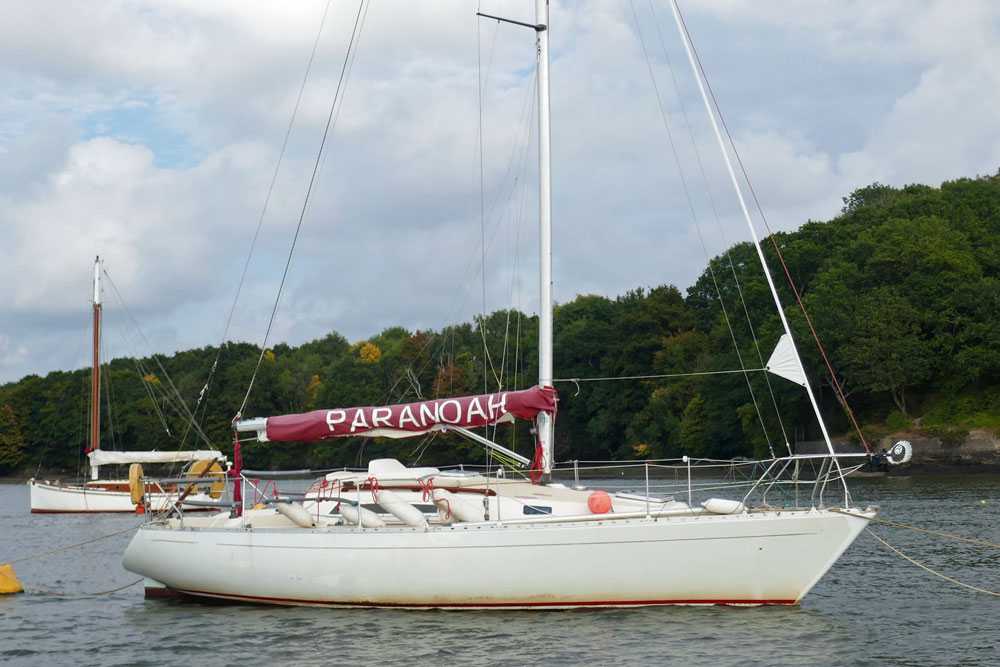- Home
- Cruising Yachts 30' to 35'
- Sigma 33 Sailboat
The Sigma 33 Sailboat
Specs & Key Performance Indicators
The Sigma 33 sailboat was designed by British naval architect David Thomas and built by Marine Projects at the company's premises in Plymouth, England. Known for its performance and reliability, the Sigma 33 has earned a good reputation within the sailing community since its introduction.
 'Paranoah', a Sigma 33 moored on the River Tamar in Southwest England
'Paranoah', a Sigma 33 moored on the River Tamar in Southwest EnglandThere were two versions of the Sigma 33:
- The cruising version, a masthead sloop sometimes known as the 33C, which is shown here, and...
- The performance version, the Sigma 33 OOD (Offshore One Design), which has a taller fractional rig and a deeper fin keel.
Published Specification for the Sigma 33 Sailboat
Keel & Rudder Configuration: Fin keel with a spade rudder
Hull Material: Fiberglass (GRP)
Length Overall (LOA): 9.8m (32'2")
Waterline Length (LWL): 7.7m (25'3")
Beam: 3.2m (10'6")
Draft: 1.75m (5'9")
Rig Type: Masthead sloop
Displacement: 4,150kg (9,150lb)
Ballast: 1,905kg (4,200lb)
Designer: David Thomas
Builder: Marine Projects (Plymouth) Ltd.
Year First Built: 1979
Year Last Built: 1991
Number Built: Approximately 390
Published Design Ratios for the Sigma 33 Sailboat
The Key Performance Indicators (KPIs)
- Sail Area/Displacement Ratio (17.8): This ratio falls within the range of 16 to 20, which suggests that the Sigma 33 has reasonably good sailing performance. It's not a high-performance racing boat but should still have decent power relative to its weight, offering a good balance between performance and handling.
- Ballast/Displacement Ratio (46.0):* With a value above 40, the Sigma 33 is considered to be a stiff and powerful boat. It should be able to stand up well to stronger winds. However, this ratio does not account for the location of the ballast. If the ballast is primarily located lower down (e.g., in a bulb at the foot of the keel), the boat would be stiffer compared to if the ballast were distributed higher up in a shallow draft keel.
- Displacement/Length Ratio (234): Falling within the moderate displacement range (200-275), the Sigma 33 is neither a lightweight nor a heavily built boat. This suggests that it requires a moderate amount of sail area to reach its hull speed. It strikes a balance between stability and performance, being solid enough to handle moderate conditions without being sluggish.
- Comfort Ratio (22.8):** This value indicates a motion characteristic of a coastal cruiser with moderate stability. It should provide a relatively comfortable ride for coastal cruising and occasional offshore passages, reflecting a level of motion that is not too harsh for most sailing enthusiasts, but it might not be as comfortable as a heavier bluewater cruiser in rough seas.
- Capsize Screening Formula (2.0): The value of 2.0 is right on the threshold for bluewater capability, suggesting that the Sigma 33 has potential for offshore passages. However, boats with a lower value are generally better suited for extended bluewater cruising. This value implies that the Sigma 33 has a reasonable balance between beam and displacement to reduce capsize risk, but it might not be the best choice for extreme conditions.
*Limitations of Ballast/Displacement Ratio: This ratio provides a general idea of a boat's stability and ability to stand up to wind, but it does not consider the distribution of the ballast. The same amount of ballast located lower in the keel (e.g., in a bulb) results in greater stability and stiffness compared to ballast distributed higher up. Understanding the exact configuration of the ballast is crucial for a complete assessment of a boat's stability.
**Comfort Ratio Considerations: Ted Brewer's Comfort Ratio tends to favor heavy displacement, narrow-beamed vessels with long overhangs, which may not accurately reflect the comfort of modern light-displacement, beamy cruisers with plumb bows. These modern designs might still provide good crew comfort and bluewater capability but score lower on the Comfort Ratio simply due to their design differences. Therefore, while the Comfort Ratio offers useful insights, it might not fully represent the comfort levels of contemporary yacht designs.
In summary, the Sigma 33 sailboat appears to be a well-balanced cruiser with good performance, reasonable stability, moderate motion comfort, and moderate suitability for bluewater passages. However, the theoretical nature of these ratios means that practical performance can vary, especially considering factors like ballast placement and modern design features that are not fully captured by traditional design ratios.
Here's how to calculate the KPIs yourself - without having to wrestle with the mathematics...
Yachting Press Reviews for the Sigma 33 Sailboat
Sailing Today says: "Jake Frith took a 1982 one design cruiser racer for a dash around the central Solent. Would this racing thoroughbred prove too flighty for cruising duties?" Read more...
Yachting Monthly tells us: "One of the most successful offshore one-designs ever launched, the Sigma 33 is also becoming widely recognised as a capable and versatile cruising yacht." Read more...
This article was written with the assistance of Gemini, a large language model developed by Google. Gemini was used to gather information, summarize research findings, and provide suggestions for the content and structure of the article.
Recent Articles
-
Albin Ballad Sailboat: Specs, Design, & Sailing Characteristics
Jul 09, 25 05:03 PM
Explore the Albin Ballad 30: detailed specs, design, sailing characteristics, and why this Swedish classic is a popular cruiser-racer. -
The Hinckley 48 Sailboat
Jul 09, 25 02:44 PM
Sailing characteristics & performance predictions, pics, specifications, dimensions and those all-important design ratios for the Hinckley 48 sailboat... -
The Hinckley Souwester 42 Sailboat
Jul 09, 25 02:05 PM
Sailing characteristics and performance predictions, pics, specifications, dimensions and those all-important design ratios for the Hinckley Souwester 42 sailboat...












